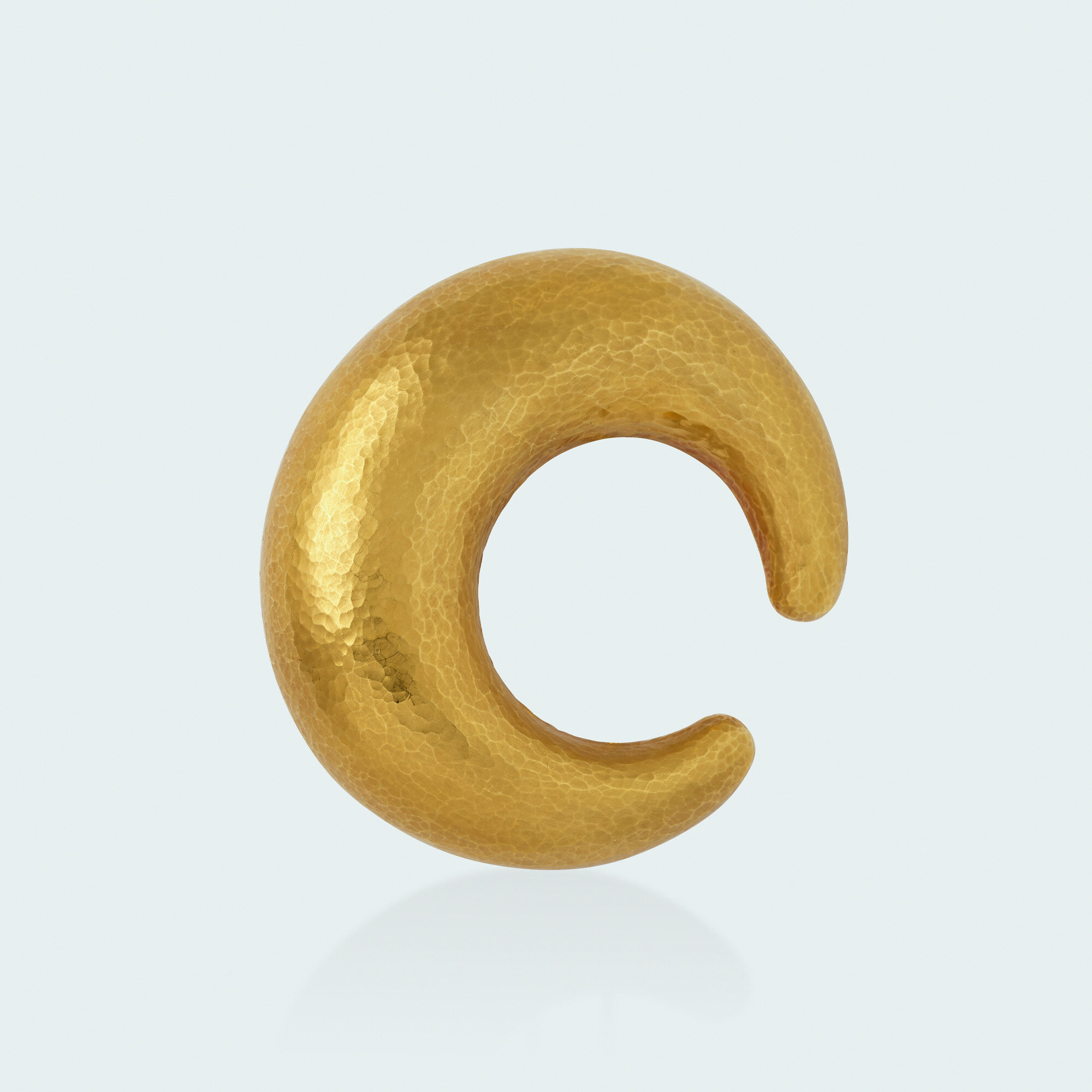219
219
Each an open form crescent moon; 1980s
18k yellow gold
Signed Paloma Picasso Tiffany & Co.
0.875 x 0.75 in; Gross weight 7.6 dwts
estimate: $1,000–1,500
result: $1,008
This work will ship from Lambertville, New Jersey.
Anne Paloma Ruiz-Picasso y Gilot, known simply as Paloma Picasso, was born in 1949 to artists Pablo Picasso and Françoise Gilot. Growing up the daughter of one of the preeminent artists of the 20th century, she was surrounded by creatives her entire life and developed friendships with many artists, socialites, and designers from Yves Saint-Laurent to Andy Warhol. Paloma began her career as a costume designer in Paris in the late 1960s and gained attention for her original jewelry designs made of rhinestones from local markets. Encouraged by this early success, she attended school for jewelry making and it was not long before Saint-Laurent commissioned her to design accessories for his collections.
By 1971, Paloma was working for Zolotas, a Greek jewelry company, and in 1980 she began designing for Tiffany & Co., a partnership that has continued for over four decades. She embodied the exciting artistic and cultural movement of 1980s New York and was a progressive choice for Tiffany at the time. Her first Tiffany collection, Paloma’s Graffiti, took something with a negative connotation and made it covetable. Explaining the aim of the collection, Paloma noted that in the 70s “people were starting to tag subways and walls, which had everyone outraged. I wanted to look at graffiti differently and try to make something positive out of it.” Decades later, Paloma’s Graffiti remains her signature collection.
Paloma inherited her father’s pioneering spirit and was among the design vanguard in the 1980s that popularized the use of bold, colorful gemstones. Her adoration of gemstones is seen throughout many of her collections such as Olive Leaf, Paloma’s Sugar Stacks and, recently, her Paloma’s Studio collection. She consistently remains ahead of trends and has received many honors for her contributions to design and fashion including the MODA award for design excellence from The Hispanic Designers Inc. and induction into the International Best Dressed List Hall of Fame. In 2011, the National Museum of Women in the Arts, in Washington, D.C. held an exhibition of her work, and she continues her work at Tiffany today, expanding upon old collections and introducing new, exciting creations.


My purpose in life is to make everything more beautiful.
Paloma Picasso
The name Tiffany is now synonymous with luxury around the globe, but the company was born from slightly more humble beginnings. In 1837, 25-year-old Charles Lewis Tiffany and his friend John Young opened a stationary and fancy goods store in New York City on Broadway. Catering to fashionable men and women, they purveyed a new “American style” more inspired by the natural world rather than the ceremonial patterns and ornamented Victorian opulence of earlier decades. In 1853, Charles Tiffany took control of the company and renamed it Tiffany & Co. By then, he had already introduced their signature, and now iconic, robin’s egg blue color.
Tiffany’s silver studio, headed by celebrated silversmith Edward C. Moore, was the first American school of design. Moore compiled an enormous collection of sketches and artwork, encouraging apprentices both to study them as well as to observe and sketch the natural world. Under his guidance, the studio developed their own design identity and became famous for elegant, Japonesque-style silver and glittering gemstone and diamond jewelry. Tiffany & Co. became the first American company to adopt the British silver standard of using only 92% pure metal, and he achieved international acclaim at the 1867 Paris World’s Fair where he was awarded the Grand Prix for silver craftsmanship; it was the first time an American design firm had been honored so by a foreign jury.
By 1870, Tiffany & Co. had become the premier silversmith in America and leading purveyor of jewels and timepieces. Tiffany purchased crown jewels from France and Spain, revolutionized the engagement ring with solitaire prong-set stones, and by the end of the century would be known as the “King of Diamonds”—a fitting title for someone who was appointed Royal Jeweler to the crowned heads of Europe, the Ottoman Emperor, and the Czar of Russia. The firm won numerous awards at international exhibitions, employed more than one thousand people, and had established branches in London, Geneva, and Paris prior to Tiffany’s death in 1902. His son, Louis Comfort Tiffany (founder of Tiffany Studios), then took the helm and became design director.
Already a leading designer and artist in the Art Nouveau and Arts & Crafts movements, the younger Tiffany stewarded the company to even greater heights. They successfully navigated changing styles, adjusting to the Art Deco aesthetic through the 1920s and 30s and, after L.C. Tiffany’s death in 1933, the more streamlined, modernized designs of the 1940s and 50s. Their success and notoriety only continued to grow throughout the 20th century as they continued to hire visionary designers such as Jean Schlumberger, Paloma Picasso, and Elsa Peretti, and garnered diverse and important commissions, from the Congressional Medal of Honor to the Vince Lombardi Trophy for the National Football League, which they have created since the first Super Bowl in 1967.
Throughout its history, America’s elite politicians, families, socialites, and actors have all frequented Tiffany & Co.: Abraham Lincoln, Franklin Roosevelt, the Vanderbilts, Astors, Whitneys and Havemeyers, Elizabeth Taylor, and Jacqueline Kennedy Onassis, to name but a few. With their global presence and steadfast dedication to excellence of quality and craftsmanship, Tiffany & Co. continues to be one of the foremost creators of silver, jewelry, and vertu in the world today.
Auction Results Tiffany & Co.